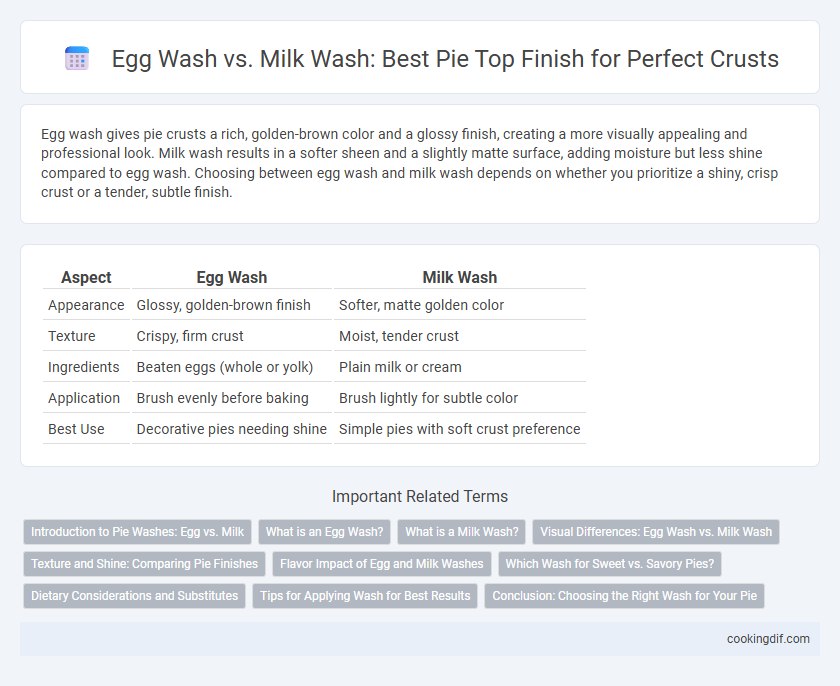Egg wash gives pie crusts a rich, golden-brown color and a glossy finish, creating a more visually appealing and professional look. Milk wash results in a softer sheen and a slightly matte surface, adding moisture but less shine compared to egg wash. Choosing between egg wash and milk wash depends on whether you prioritize a shiny, crisp crust or a tender, subtle finish.
Table of Comparison
| Aspect | Egg Wash | Milk Wash |
|---|---|---|
| Appearance | Glossy, golden-brown finish | Softer, matte golden color |
| Texture | Crispy, firm crust | Moist, tender crust |
| Ingredients | Beaten eggs (whole or yolk) | Plain milk or cream |
| Application | Brush evenly before baking | Brush lightly for subtle color |
| Best Use | Decorative pies needing shine | Simple pies with soft crust preference |
Introduction to Pie Washes: Egg vs. Milk
Egg wash, typically made from beaten eggs sometimes mixed with water or milk, creates a glossy, golden-brown finish that enhances the visual appeal of pie crusts. Milk wash, composed of milk or cream, contributes to a softer, matte finish with a subtle browning effect, ideal for a gentler crust appearance. Understanding the distinct textures and color development each wash imparts helps bakers achieve the desired aesthetic and crust texture for various pie recipes.
What is an Egg Wash?
An egg wash is a mixture of beaten eggs, sometimes combined with water or milk, brushed onto pie crusts before baking to create a glossy, golden-brown finish. It enhances the pie's appearance by promoting even browning and adds a slight sheen that milk washes alone cannot achieve. Egg wash is preferred for its ability to produce a crisp, attractive crust while also helping toppings or sugar adhere to the pie surface.
What is a Milk Wash?
Milk wash, commonly used for pie top finishes, is a simple coating made by brushing milk onto the dough before baking, creating a soft, golden-brown crust with a subtle sheen. Unlike egg wash, milk wash offers a gentler color and less shine, making it ideal for achieving a delicate, matte finish on fruit pies and pastries. The natural sugars and proteins in milk enhance browning through the Maillard reaction, contributing to an evenly baked and slightly caramelized surface.
Visual Differences: Egg Wash vs. Milk Wash
Egg wash creates a shiny, golden-brown crust with a slightly crisp texture, enhancing the pie's visual appeal through its glossy finish. Milk wash produces a softer, matte surface with a subtle brown hue, offering a more natural and rustic look. Choosing between egg wash and milk wash affects the pie's final appearance, with egg wash delivering brilliance and milk wash providing a muted glow.
Texture and Shine: Comparing Pie Finishes
Egg wash imparts a glossy, deep golden finish on pie crusts, creating a crisp texture that enhances visual appeal with a rich shine. Milk wash results in a softer, matte crust with a tender texture, offering subtle browning and a less pronounced gloss. Choosing egg wash or milk wash significantly influences the final pie's surface texture and luminous quality, catering to different aesthetic and textural preferences.
Flavor Impact of Egg and Milk Washes
Egg wash enhances pie crusts by imparting a rich, savory flavor and a deep golden-brown color due to the proteins and fats in the egg yolk. Milk wash provides a subtler taste with a softer, more matte finish, contributing slight sweetness and moisture without overpowering the pastry's natural flavor. Choosing between egg and milk wash depends on the desired balance of flavor richness and crust texture for the perfect pie presentation.
Which Wash for Sweet vs. Savory Pies?
Egg wash creates a glossy, golden-brown finish ideal for savory pies, enhancing crust crispness and color. Milk wash yields a softer, matte finish that complements sweet pies by adding subtle browning without overpowering delicate flavors. Choosing between egg and milk wash depends on the flavor profile and desired crust texture of the pie.
Dietary Considerations and Substitutes
Egg wash offers a glossy, golden finish but poses allergen concerns for individuals with egg allergies or dietary restrictions such as veganism. Milk wash provides a milder sheen and is suitable for those avoiding eggs, though it contains dairy and may not be appropriate for lactose-intolerant or vegan diets. Plant-based substitutes like almond milk or coconut milk washes deliver an egg- and dairy-free alternative, catering to vegan, lactose-intolerant, and allergy-sensitive individuals while still ensuring an appealing pie crust finish.
Tips for Applying Wash for Best Results
Use egg wash for a glossy, deep golden finish on pie crusts, applying with a pastry brush in thin, even layers to avoid sogginess. Milk wash delivers a softer sheen and subtle browning; apply lightly to prevent a dull or sticky surface. For optimal results, apply wash just before baking and avoid brushing over fruit filling to maintain a clean, crisp crust.
Conclusion: Choosing the Right Wash for Your Pie
Egg wash provides a glossy, golden-brown finish with excellent adhesion, ideal for decorative pies requiring a shiny, firm crust. Milk wash creates a softer, matte appearance with subtle browning, perfect for rustic, tender crusts without crust cracking. Selecting the right wash depends on the desired texture, appearance, and pie type to ensure the best visual and tactile outcome.
Egg wash vs Milk wash for pie top finish Infographic

 cookingdif.com
cookingdif.com